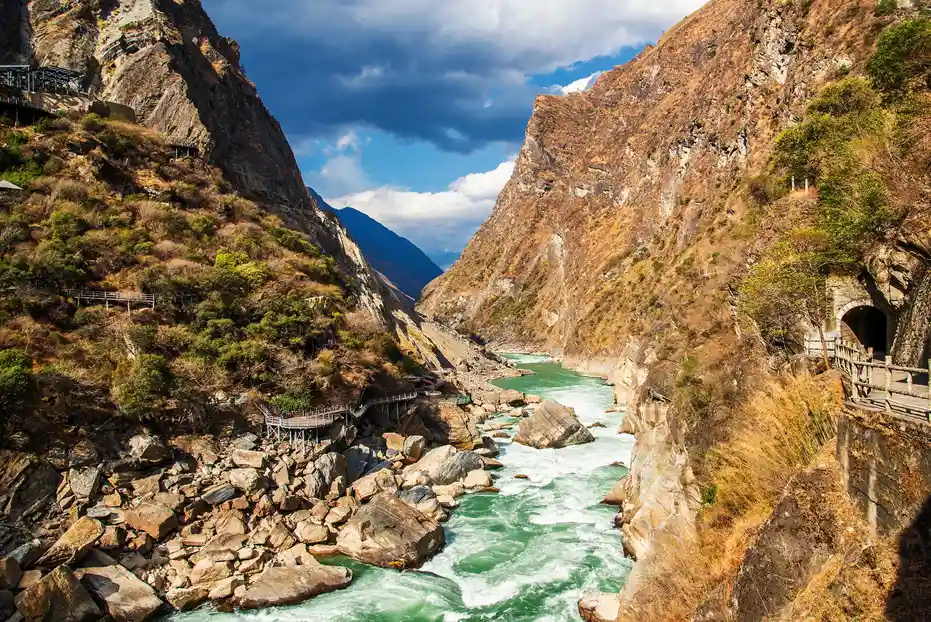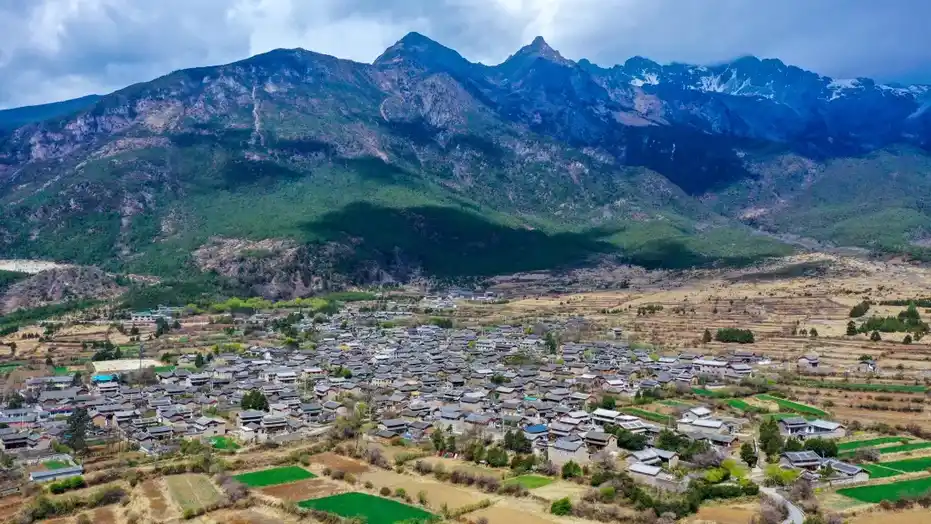Introduction: Why Tiger Leaping Gorge Should Be on Your Hiking Bucket List
Tiger Leaping Gorge is one of the most breathtaking hikes in China. Carved by the Yangtze River, it cuts through the mountains between Jade Dragon Snow Mountain and Haba Snow Mountain. The gorge is over 3,700 meters deep in places—making it one of the deepest canyons in the world.
This trail isn’t just for expert hikers. With well-marked paths and guesthouses along the way, it’s accessible to travelers of all fitness levels. Whether you’re a seasoned trekker or a nature lover looking for adventure, this journey offers stunning views, cultural encounters, and a real sense of escape.
In this guide, we’ll walk you through everything you need to know. From trail options and best times to visit, to packing tips and local customs. By the end, you’ll feel confident planning your own Tiger Leaping Gorge adventure.
The trail takes about two to three days to complete. You’ll pass waterfalls, tea houses, and remote villages. Each turn reveals a new vista more dramatic than the last. It’s no wonder this hike ranks among Asia’s top treks.
Let’s dive into what makes this journey so special—and how you can make the most of it.
Where Is Tiger Leaping Gorge Located?
Tiger Leaping Gorge lies in Yunnan Province, southwest China. It’s about 60 kilometers north of Lijiang, a popular tourist town. The nearest major city, Lijiang, is well-connected by bus and flights.
The gorge splits into three sections: Upper, Middle, and Lower. Most hikers start in Qiaotou, a small village at the northern end. From there, the trail winds south toward Daju or Tina’s Guesthouse.
The area sits in a remote mountain valley. Despite growing tourism, it still feels wild and untouched. You’ll see terraced farms, rushing rivers, and snow-capped peaks.
Getting there usually starts with a bus from Lijiang to Qiaotou. The ride takes around 2 hours. Buses run daily, but schedules can change. It’s best to check locally or ask your guesthouse to help arrange transport.
Here’s a quick overview of the route:
– Start: Qiaotou Village
– Main Trail: Upper Gorge → Middle Gorge → Tina’s Guesthouse
– End: Daju or Baishuitai (depending on your route)
The trail is well-marked. Signposts and guesthouses make navigation easy. Still, carrying a map or offline GPS is smart.
Why the Name “Tiger Leaping Gorge”?
Legend says a tiger once leaped across the narrowest part of the gorge to escape a hunter. That spot is now called “Tiger Leaping Stone.” It’s just 25 meters wide, with the river roaring below.
Whether or not tigers actually jump there, the name adds to the mystique. The story reflects the raw power and drama of the landscape.
Today, no tigers live here. But you might spot langurs, pheasants, or even a Himalayan black bear (from a distance!). The region is rich in biodiversity.
The myth also ties into local Naxi culture. The Naxi people have lived in this area for centuries. Their traditions and respect for nature shape the region’s character.
So while you hike, remember—you’re walking through a place where myth, nature, and culture meet.
Best Time to Visit Tiger Leaping Gorge
Timing your trip right can make or break your experience. The ideal months are **April to June** and **September to October**.
During these periods, the weather is mild, skies are clear, and trails are dry. You’ll get the best views of the snow peaks and green valleys.
July and August bring the monsoon season. Rain can make paths slippery and landslides more likely. Some guesthouses may close. Still, if you don’t mind wet weather, you’ll have fewer crowds.
Winter (November to March) is cold, especially at higher elevations. Snow can block parts of the trail. But if you’re prepared for chilly temps, you’ll enjoy crisp air and stunning icy views.
Avoid Chinese public holidays like Golden Week (early October). The trail gets crowded, and guesthouses book up fast.
Here’s a quick seasonal guide:
| Season | Pros | Cons |
|---|---|---|
| Spring (Apr–Jun) | Clear skies, blooming flowers | Slightly more tourists |
| Summer (Jul–Aug) | Lush greenery | Rain, mud, landslides |
| Fall (Sep–Oct) | Cool temps, golden light | Busy during holidays |
| Winter (Nov–Mar) | Few crowds, snow views | Cold, some closures |
Choosing Your Hiking Route
There are two main routes: the **High Trail** and the **Low Trail**.
The High Trail is the classic choice. It’s higher in elevation, with panoramic views of the gorge and snow peaks. It takes 2–3 days and passes several guesthouses.
The Low Trail runs closer to the river. It’s shorter and flatter, good for a day hike. But you miss the big mountain views.
Most travelers choose the High Trail. It’s more scenic and offers a real trekking experience.
Here’s a breakdown of the High Trail:
– **Day 1**: Qiaotou to Halfway House (6–7 hours)
– **Day 2**: Halfway House to Tina’s Guesthouse (5–6 hours)
– **Optional Day 3**: Side trip to Snow Mountain or continue to Daju
You can hike north to south or reverse. South to north gives better views, as the sun lights the peaks in the morning.
Each night, you’ll stay in a simple but clean guesthouse. They offer meals, beds, and hot water—luxuries after a long day of hiking.
What to Pack for Your Trek
Packing smart makes your hike more comfortable. The weather can change fast in the mountains. Layers are key.
Start with a good pair of hiking boots. The trail has rocky sections, steep stairs, and uneven ground. Supportive shoes prevent slips and blisters.
Your backpack should be 30–40 liters. Include these essentials:
– Moisture-wicking clothes (avoid cotton)
– Insulating layers (fleece or down jacket)
– Rain jacket or poncho
– Hat and gloves (even in summer)
– Reusable water bottle or hydration system
– Snacks (nuts, energy bars, dried fruit)
– Headlamp or flashlight
– Basic first aid kit
– Sunscreen and lip balm
– Toilet paper and hand sanitizer
You don’t need to carry a tent. Guesthouses provide lodging. But bring a sleep sack if you’re picky about cleanliness.
Most guesthouses sell food and water. But prices go up the deeper you go. Stock up in Qiaotou if possible.
Staying at Tiger Leaping Gorge Guesthouses
Guesthouses are a highlight of the trek. They’re run by local families and offer warm hospitality.
Most have shared dorms or private rooms. Beds come with blankets. Showers are often solar-heated and available in the afternoon.
Meals are simple but filling. Expect rice, vegetables, noodles, and sometimes meat. Tea and hot chocolate are always on the menu.
Here are a few popular stops:
– **Jane’s Guesthouse** (Upper Gorge): Great views, friendly owner
– **Halfway House**: Exactly what it sounds like—midway point with strong coffee
– **Tina’s Guesthouse**: A favorite with great food and cozy rooms
Prices range from $5–15 per night. Meals cost $3–6. Pay in cash (Chinese yuan).
Wi-Fi is spotty or nonexistent. Embrace the digital detox!
Local Culture and Responsible Travel Tips
The region is home to the Naxi and Yi ethnic groups. Their villages dot the hillsides. Many work in farming or tourism.
When visiting, be respectful. Ask before taking photos of people. Learn a few basic Chinese or Naxi greetings.
Leave no trace. Pack out all trash. Don’t litter, even biodegradable items like fruit peels. They don’t decompose fast in cold climates.
Stick to marked trails. Avoid disturbing wildlife or picking plants. The ecosystem is fragile.
Support local businesses. Eat at family-run guesthouses. Buy handicrafts directly from artisans.
Remember, you’re a guest in their home. Small acts of kindness go a long way.
Challenges You Might Face on the Trail
Even with good planning, challenges can arise. The biggest one is altitude.
Qiaotou sits at about 1,800 meters. The trail climbs to over 2,600 meters. Some people feel shortness of breath or headaches.
To reduce altitude effects, walk slowly and stay hydrated. Drink plenty of water and avoid alcohol.
Another challenge is the famous “28 Bends.” This steep section has 28 hairpin turns up a cliffside. It’s tough on the knees but worth it for the view.
Weather changes fast. A sunny morning can turn into a foggy, rainy afternoon. Always carry rain gear.
Finally, some guesthouses may run out of food or hot water. It happens. Stay flexible and patient.
How to Get to and From the Gorge
Most hikers start in Lijiang. From there, take a public bus or hire a private car to Qiaotou.
Public buses leave from Lijiang’s new bus station. They cost around $2–3 and take 2 hours. Ask for the “Tiger Leaping Gorge” bus.
If you’re ending in Daju, you can take a bus to Shangri-La. It’s a scenic ride through mountain passes.
Alternatively, many hikers return to Lijiang via Tina’s Guesthouse. A minivan can take you back for about $10–15.
Always confirm transport times in advance. Schedules are not always posted online.
Final Thoughts: Is Tiger Leaping Gorge Worth It?
Absolutely. Tiger Leaping Gorge offers a rare mix of natural beauty, cultural depth, and physical challenge.
It’s not just a hike—it’s an experience. You’ll disconnect from daily life and reconnect with nature.
The trail is well-established, safe, and rewarding. With proper planning, anyone in decent shape can do it.
Go in the shoulder seasons for the best weather and fewer crowds. Pack light but smart. Respect the land and the people.
Whether you’re chasing views, adventure, or peace, this trek delivers.
So lace up your boots, grab your backpack, and take the leap—just like the tiger.



